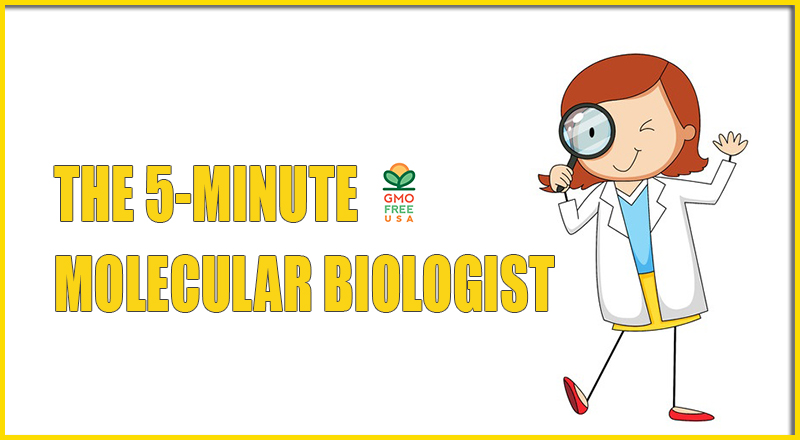This lady gives great insight into what we do and don’t know about GMO‘s. It is a worth while read to grasp a better understanding of why GMO’s need to be researched more before ingesting.
By LISA M. VAN ES
APRIL 02, 2016
You might have copied off a girl like me in high school. I usually got straight Aʼs and I wasn’t very stingy about covering my paper. My academic discipline led me to complete a degree in Molecular Biology at the University of California at San Diego and I spent over 15 successful years in the biotech and healthcare industries. Many of these years were spent educating doctors in Genetics and Genomics technologies.
I am just about as pro-technology as someone can be. I did Bioinformatics work for the Microbial Genetics Lab at UCSD when the internet was still called “the information superhighway”. I fell in love with science on career day in 7th grade. A veterinary scientist performed a color-based diagnostic for my class and when the reagent in the test tube turned green my heart leapt with joy. Ten years later I was educating doctors about molecular diagnostics for LabCorp’s Center for Molecular Biology and Pathology. When I realized the limitations of Genomics I worked in Proteomics, NanoBioTech, Applied ElectroMagnetism, and eventually did some Quantum Aerospace Engineering. I support good science based on tested principles and research. I support honest science that’s based on independent assessment of good, clean data.
Iʼm often shocked when the subject of GMOs comes up and although everyone agrees they should be labeled, there also seems to be a mistaken consensus that the genetics of GMOs are “safe” or “natural.” This assumption of safety is very dangerous and I feel it’s my duty as an American Scientist to come forward and educate the public about what’s really going on with the genetic modification of our food. Many scientists have been afraid to come forward because anti-GMO sentiments are controlled by the corporate fascism of the Agrichemical giants. Data is seized and threats are given to remain quiet. Truth is discredited and replaced with propaganda. But I can’t be bullied to remain quiet and I’m not sharing data from a specific scientific study. What I’m about to share with you is birthed from the combination of good science and common sense.
I’m going to give you the Cliffs Notes to my years of studying molecular biology without you having to attend the stinky cloning laboratories or overcrowded lecture halls of a university. I’m about to make you a molecular biologist in less than 5 minutes by simply reading this article. Here are 4 basic principles to help you understand the science behind why GMOs are a danger to public and planetary safety.
1- Changing DNA Changes Everything
The most basic principle for understanding molecular biology is that the DNA code drives all other cell processes. A messenger molecule called RNA is encoded from DNA and it moves from the nucleus into the cytoplasm to create all the proteins we need for life. It looks like this:
DNA —> RNA —> Protein
So if we change the DNA code, what happens to the proteins we need for life? They change too. How do these changes affect us? According to many hundreds of scientific studies from around the world[1] and U.S. Universities like MIT, GMO consumption is related to stomach barrier damage[2], increased risk of intestinal infections[3], anxiety[4], high cholesterol, high blood sugar[5]; reproductive issues including lower birth weight and increased mortality of offspring[4][6][7][8]; organ disturbances in the pancreas[9][10][11], liver[12][13][14][15][16], kidneys[16][17][18][19], adrenal glands[18][19][20], ovaries and testes[15][16][21][22][23]; and other disturbances including disturbances to the immune system[24], blood biochemistry[25] and functioning of the digestive system.[16] According to some independent scientists, eating GMOs is far from safe and highly unnatural. You can’t change the natural sequence of genetic information within the DNA of food crops, spray it with barrels of toxic pesticides like glyphosate, and believe it’s not going to hurt our bodies.GMOs are the result of bad science that contradicts the central dogma of molecular biology. Nature designed organic food and corporations designed GMOs. Assuming safety or nutritional equivalence of GM foods has no basis in good science.
The definition of a gene has radically changed since the birth of Modern Genetics in the late 1990s. It used to be defined as the segment of DNA that encodes for one protein. But then a phenomena called alternative splicing was discovered and scientists realized a single gene could encode for more than one protein depending on how it’s regulated. Remember doing Punnett Squares in high school biology to determine eye color following the laws of classical Mendelian Genetics? That’s changed too. “The earlier belief that blue eye color is a simple recessive trait has been shown to be incorrect. The genetics of eye color are so complex that almost any parent-child combination of eye colors can occur.”[26]
The field of Modern Genetics is relatively in its beginning stages. The science is nowhere near the understanding of the human genome that would make it safe for us to eat what they’re splicing up in the lab.
2- We just don’t know
Have we really cracked the code? How would you react if you had a friend that bought a map of Mount Everest and claimed they had been to the top? Pretty ridiculous. It might shock you to realize this is tantamount to scientists claiming they’ve cracked the code, when really our understanding of gene regulation is still very limited.Although scientists have sequenced the genome we just don’t know what approximately 98% of it actually does. Genes are defined as the parts of our DNA that encode for proteins, yet only about 2% of our genome has this encoding function. What does the rest of the DNA do? We just don’t understand, therefore scientists call it “junk DNA”. The fancier term is non-coding regions and scientists don’t know why they exist. Billions and billions of base pairs are still a complete mystery to modern genetics.
There are conflicting opinions about junk DNA but no facts or consensus. Some studies have pointed out 3, 5, 8.2, and all the way up to 20% of the genome is actually understood, but there is still no consensus. Until we understand this “junk”, we’re eating junk in GMO food that’s galavanting around under the guise of nutrition. Until there is a radical shift in the consensus and understanding of junk DNA function and regulation, no gene technology including CRISPR can be deemed safe.
We are still at Base Camp when it comes to climbing the mountain to understanding the complex function and regulation of genes. Younger areas of molecular study like Epigenetics and the Biology of Consciousness are still riding a shaggy old yak to Base Camp. We have a rough map but we are far from making it to the top. Until we can define non-coding regions in relation to the regulation of active gene segments, gene splicing instruments are just expensive toys. The biotech industry wants you to think gene technologies are safe so they can keep attracting millions in investment dollars for the commercialization of unsafe and untested technologies, while using you as their free guinea pig.
3- Enzymes hold the Key
Have you ever gotten home tired and put the wrong key in the lock? It just doesn’t work. This is what happens when our bodies try to digest GMO food. It just doesn’t work. It’s a principle called enzyme-substrate specificity and in this context the “substrate” is the food we’re eating. We were not born with digestive enzymes that recognize genetically modified food, so the key is not fitting in the lock. This potential buildup of metabolic waste may become toxic to our digestive system.
If we change the natural sequence of genetic information within the DNA of food crops we are changing the structure of our food and our body’s ability to digest and assimilate its nutrition. It can also change the levels of vitamins and minerals making them potentially less nutritious.[27][28] GMOs have created an American society that is both starving for nutrition and obese at the same time. It’s going to sink the healthcare system if we don’t switch to organic farming practices now. It’s a complete contradiction that GMOs are artificial enough to patent yet “natural” enough to bypass FDA labeling standards and testing requirements.
Current CFSAN (FDAʼs Center for Food Safety and Applied Nutrition) Director Susan Mayne holds a PhD in Nutritional Biochemistry. She should understand this concept of enzyme specificity enough to demand more safety data from the Agrichemical companies who have somehow convinced the FDA to waive proper safety testing requirements. GMOs were forced into our food supply without proper regulation by methods of corporate fascism. As FDA spokesperson Theresa Eisenman explained, “It is the manufacturer’s responsibility to ensure that the [GMO] food products it offers for sale are safe.” In a Roundup sprayed nutshell, the FDA is basically taking Monsantoʼs word that GMOs do not pose a great risk to public health and safety. Why would safety testing be waived in the face of bad science? Ask former Monsanto employee turned current FDA food safety Czar, Michael Taylor. Remember when we were also told that it’s safe to use DDT and Freon? GMOs have enough independent scientific data to prove they are harmful to our bodies and environment and we must demand action now.
4- Modification vs Hybridization
Genetic Modification and Natural Hybridization are mistakenly assumed to be a similar process by most people. Gene splicing to create GMOs is marketed to seem like a “natural” process in the lab and there’s much confusion between genetic hybrids and naturally occurring hybrids. But the process of Genetic Modification is about as “natural” as an elephant mating with a chihuahua. There is nothing natural, safe, or spontaneous about it.
For a plant cell to accept the foreign and artificially manufactured DNA strand during genetic modification, it must be forced open, such as with electricity in a method called electroporation. The elephant never received the chihuahuaʼs consent. Ouch. The cell is forced to receive bacterial and viral DNA that it was never meant to mix together with. Adding to the horror, the strands of foreign DNA could recombine with human and plant DNA in ways that are totally dangerous and highly unpredictable. Scary. About as scary as the fact that antibiotic resistance markers are cloned into the foreign DNA strands so the food we are eating could mutate with the DNA of our own intestinal microbiota[29] and cause the biggest antibiotic resistance epidemic we’ve ever seen in America. This forced interspecies transfer process of genetic modification bears no relation to the natural process of hybridization.
Americans have been fed blatant lies about GMOs and it’s about time we demand clear on-package labels to better track allergic reactions and adverse events related to their consumption. Unleashing these untested GMOs into the public food supply is scientific insanity. GMOs have never been “proven safe” and actually threaten our ability to “feed the world” when you look beyond the propaganda at the facts.
In March of 2015, the same month the World Health Organization deemed the Glyphosate chemical counterpart of GMOs as a probable carcinogen, Senator Ted Cruz was demonizing the anti-GMO movement as “anti-science zealotry”. How has he earned the right to have such a strong opinion on GMOs? Has he ever read a single independent scientific study on GMOs? Like most politicians he probably hasn’t read much beyond the words “Pay to the Order of” on the Agrochemical bribe checks he cashes. Paradoxically, he became an anti-science zealot by proclaiming such a strong pro-GMO stance without doing the work to first understand the science behind his opinion. He’s the kind of guy that used to copy off girls like me in high school and it’s finally going to catch up with him. A strong democracy depends on a highly educated society that does their research before forming strong opinions. My opinion can’t be bought and I’m wielding the power of the pen to protect my beloved America from the poison of GMOs.
Unless you want to see the natural disaster equivalent of an angry chihuahua head on a charging elephant’s body, let’s demand more safety studies on GMOs in the name of good science. Let’s align our food supply with the key principles of genetics and get GMOs out of the grocery store and back into the lab. Now, go hang your honorary degree in Molecular Biology and share your scientific brilliance with your friends, families, and senators. A healthy future for America depends on your voice.
–Lisa M. van Es
References





